How I Spent My Summer Vacation
Copyright by Rey McGehee 2004.
It was over three years ago that
I found a web site dedicated to hunting with borzoi in Russia. I e-mailed
the site owner and that began an e-mail friendship which led to an exchange
of borzoi hunting videos, and eventually to an invitation to visit Russia
and see borzoi in their native land. The first Perm Sighthound Conference
was planned. The invitation from my Russian friend Alexander Lyutin came
in April, and we began the paper work on both sides of the world. There
was the filing of the personal invitation with OVIR, which is required
to visit Russia; followed by the expedited shipping of the required official
invitation form necessary to obtain a Russian visa; followed by the expedited
acquisition of my birth certificate which is required to obtain a US passport
(this was not so easy, as I was born in England and the seal required in
the US for a passport was unobtainable from England); the expedited application
for the passport itself; followed by the expedited overnight application
to the Russian Consulate for the visa itself; and, finally, the airline
tickets. Everywhere it says “expedited”, read, “triple the normal cost”.
It was a rush to get everything done by the end of July, and the date of
my flight was delayed almost to the very day of the scheduled Sighthound
Conference; but on July 22nd, I was on the plane to Moscow.
First there was the 2 hour drive
from Moscow, Idaho to the Spokane, WA airport; then the brief 1 hour flight
to Seattle WA, followed by a 2 hour layover; and then the 11 hour flight
over the North Pole to the “other” Moscow. I then had a 12-hour wait
in Moscow for the flight to Perm. I arrived in Perm at 5:10 AM, 28 hours
after starting out, and I was met by Alexander and his friend Antone.
Antone had a car and was our driver; not everyone in Russia has a car.
We were immediately off to the small village of Kalinino, about 100 kilometers
from Perm, where the Hunt Club borzoi show was to take place that very
day. Perm is a city of about 1 million in the Ural Mountains. It was a
closed city under the USSR because of factories located there.
Kalinino is a rural weekend getaway
place for the people living in industrial Perm. We arrived at the house
where we were to stay, which was set up for visitors. There were rooms
upstairs for sleeping and a pleasant porch for sitting, talking and eating.
I was fed almost as soon as I arrived, and I think I ate 6 times that day.
All the food was very good, with fresh tomatoes and cucumbers, bread, soups,
and of course, vodka. It was a whirlwind day as, still without having slept,
I met everyone. Many spoke some English, and a couple of people who spoke
very good English translated for me.
Almost as soon as I arrived the
people started to talk about borzoi, wanting to know about the borzoi in
the US. Because of the conference and Hunt Club borzoi show, many of the
people were borzoi people, though there were also hunters with other sighthound
breeds. The morning was spent just getting to know people and eating and
resting. Some young college women who were collecting and preserving Russian
folk songs came and sang these traditional Russian songs. Their voices
had an impressive resonance and the songs were strong and moving. The people
were very friendly, and they were all concerned that I was having a good
time.
We had the dog show later
in the day, after waiting for some of the participants to arrive; people
commonly travel long distances by train with their dogs because of lack
of cars. The show was held under the Hunt Club rules, in contrast to FCI
or US rules. It was interesting to see an example of how the Hunt Club
shows are conducted. In this case there were two judges, who discussed
each exhibit at length. The concentration is on the structure of the dog,
and not on the person or the presentation. The judge spends much
more time on each dog than the judges in the US do. Each dog is measured
to assess proportions. The dogs are walked and observed for an extended
period. Then each entrant receives a rating and a written critique detailing
strengths and weaknesses as perceived by the judges.
At the end of the day it
was time for the traditional Russian steam bath, called the banya. The
banyas are located in small sheds or buildings near the houses. They are
a mostly dry bath in which a water and beer mixture is poured over hot
rocks, creating steam. The banya was very warm and relaxing. After heating
up for a while, we would run out to the stream and pour cold water over
ourselves to cool down, then go back into the banya again. In the banya
there was a bundle of small birch branches with the leaves on. These can
be used to beat yourself with, to stimulate blood flow; you can also have
a friend wield the branches for you. After the banya it was off to bed
for the first time in 3 days.
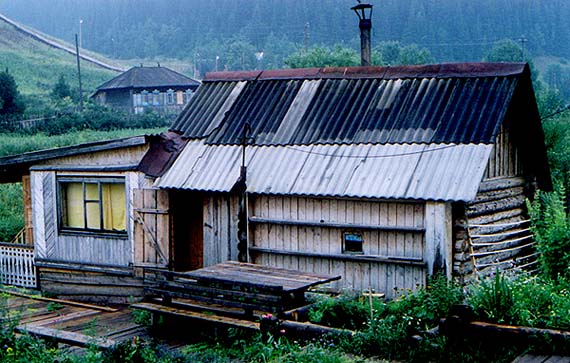
The Banya
The next day was the sighthound
conference. My friend Alexander gave a presentation on a proposal to have
regional champions, and there was a presentation on starting a state breeding
program in the Nizhni Novgorod area of Russia. I presented two papers at
the conference, one by myself and one by my wife Yvonne. My presentation
was on open field coursing in America. The Russians are very interested
in how we practice hunting here, and they ask many questions about our
rules, rabbits, judging, and terrain. Then I presented Yvonne’s paper,
which was on the Borzoi Club of America logo and how it has changed over
time, from an old logo which portrayed working sighthound qualities, to
the more recent logo which portrays a generic show dog lacking particular
sighthound qualities. The Russians were most interested in this presentation
and the ensuing discussion of the borzoi structure. They were very interested
in discussing what makes a good functional borzoi, and they were very dismayed
by the fact that many Americans had no interest in the functionality of
the breed or in hunting with sighthounds.
That evening, as it was
getting dark, Alexander and I took a walk around the village and we talked
about borzoi. We got onto the subject of the “brossok”. The brossok is
the last minute burst of speed that a borzoi makes just as it reaches the
game. The old Russians breeders felt that the brossok was specific to the
Borzoi breed, and they described it as “a bullet leaving the gun”. Alexander
felt that he had only seen this a few times in his life, and that if a
Borzoi could not exhibit brossok, maybe they were not, truly, a Borzoi.
This was one of the differences that I saw in Russia from the American
show fancier. The Russians were interested in the abilities of the dogs,
unseen qualities that make the breed different from other breeds. A dog
is defined by what it does, rather than entirely by how it looks. This
is actually similar to how sled dog racers define whether a dog is an Alaskan
or not; by how it does, not by how it looks. Many of the show people in
America are only concerned with the external features of the dog and do
not consider anything else to be important. After our walk it was back
to the house, the banya, and then to bed.
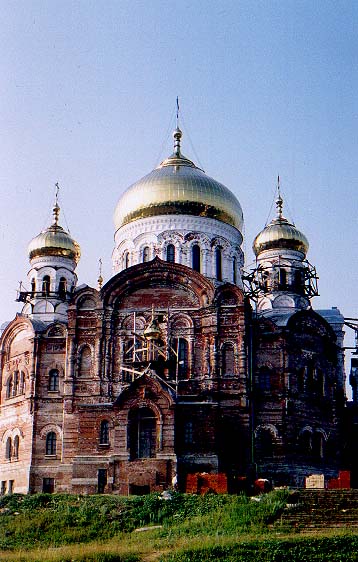
I spent the next few days
sightseeing around Perm. We took a drive north through the Urals to see
some of the churches and the countryside. We had a nice visit with Yura,
another borzoi judge, or “expert” as judges are called in Russia. Then
we were invited to come and see the largest borzoi kennel in Siberia, so
on Friday Alexander and I took a train to the city of Omsk, in Siberia.
It was a 20-hour train ride, through the Urals and part of Siberia. It
was a nice relaxing train ride, and Alexander and I talked about borzoi
again. One point was of great interest me, because of the stretching out
of the rear legs so commonly seen in the show ring in America. In the Russian
Hunt Club rules of judging, if a line is dropped from the point of the
hip to the ground, the hind foot should be from 5 to 8 cm behind that line
and no further. This is a distance of about 2 to 3 ¼ inches. In
the American show ring, we are seeing a trend to stretch the hind foot
farther and farther back, with the rear assembly dropping so the hip falls
significantly below the level of the whithers. This produces a large angle
at the stifle as the rear sags down, similar to that seen in the show German
Shepherd Dog. This is not the traditional rear in the sighthounds, which
have historically had long rear bones with relatively open angles and hips
held at approximately the same level as the whithers. It would help to
preserve the original long-boned, open-angled borzoi rear, to have some
statement about this in the American standard.
We spent the night on the
train sharing a compartment with two women and a girl. I think they were
mother, daughter, and grand daughter. They were very nice people, their
stop came in the middle of the night and as they were leaving I was awakened
by one of them very gently covering me with a blanket.
We were met at the
station in Omsk by Lena, who hunts with her two adult borzoi and is a frequent
visitor at the kennel we were going to visit, and two young men who gave
us a quick tour of Omsk. Omsk is a city of about one million that was founded
in 1716. After the tour we went out to Grisha’s vast farm, which is located
about 100 kilometers from Omsk and near the border with Kazakhstan. Grisha
has a beautiful kennel, the largest in Siberia. There are large fenced
areas for puppies along with smaller areas for adults and for mothers with
puppies. He has a large enclosure in which he raises hares to train the
young dogs on. There is a straight racing set up with boxes, and he even
has a wolf for training purposes. Grisha’s dream is to build a Borzoi hunt
like the hunts of old Russia. He raises horses and fox hounds to be used
in the hunt. His land stretches as far as the eye can see and beyond, even
in flat Siberia. He plans to fence in an area, approximately 10 miles by
10 miles, to keep in game for the borzoi hunts. He has stopped hunting
of hares with guns on his land, in efforts to increase the wild hare population.
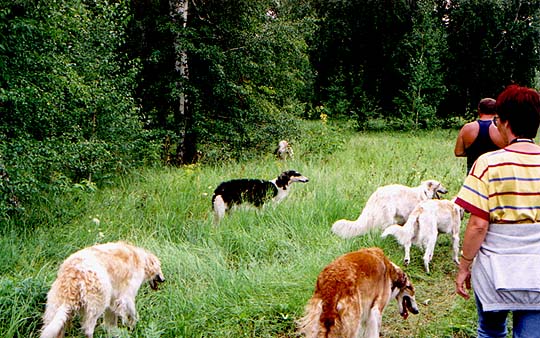
Grisha and Lana and the dogs.
The first night at Grisha’s we
went out on a hunt, driving across the fields looking for eyes reflecting
in the headlights of the van. All they caught that night was a rodent that
looked like a large Kangaroo rat. After the hunt it was off to the banya;
there was no stream near the bath this time, so to cool off there was a
large tub of cold water that you could dump on yourself.
The next day was spent looking
at the dogs and walking around the area a little. Siberia is very beautiful,
very flat with large grassy fields and islands of birch trees. And very
large; endless open space as far as you can see. That night we went on
another hunt, for Corsak fox, a small steppe fox. We found three for the
dogs to chase and it was a fun time bouncing across the fields trying to
keep the fox in the headlights so the dogs could see. The dogs caught 3
Corsaks that night; then we were off to the banya again. This time after
cooling off with the cold water we walked out into the dark and stood there
for awhile; it was raining. So there I was, this middle aged guy from Idaho,
standing naked in the rain in Siberia, all because I e-mailed a guy in
Russia about his web site, and because of our mutual interest in functional
borzoi; there I was.
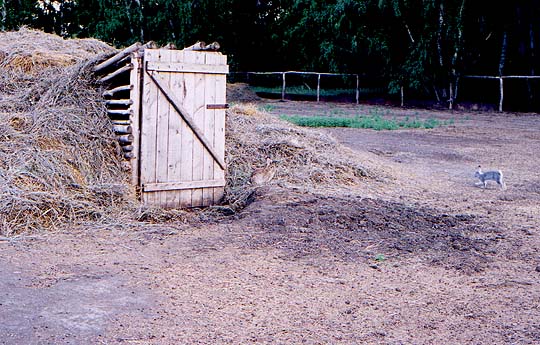 .
.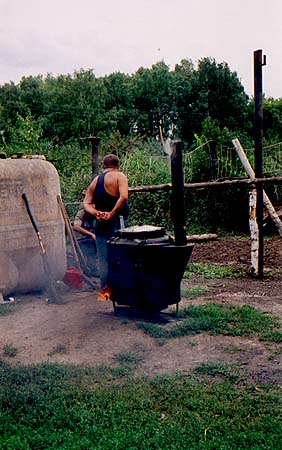
Hare house.
Dog food stove.
The next day in Omsk was a borzoi
day. They held several straight races for me to video. There was a starting
box very similar to what you would see in America, but in some of the slots
they would put two dogs instead of one. They would also hand slip
a dog or two, so that there were 7 or 8 dogs running at one time. A hand-cranked
lure with a fox skin over a plastic milk jug was used, and the dogs would
run between two and three hundred yards. There was no one at the end of
the run to catch up the dogs and they would all run back to the starting
box almost as fast as they ran out on the lure. After the racing they paraded
the dogs around the field so that I could get a better look at then. The
whole kennel is set up with performance in mind; Grisha is really trying
to return the Russian borzoi to what it was 100 years ago, based on hunting.
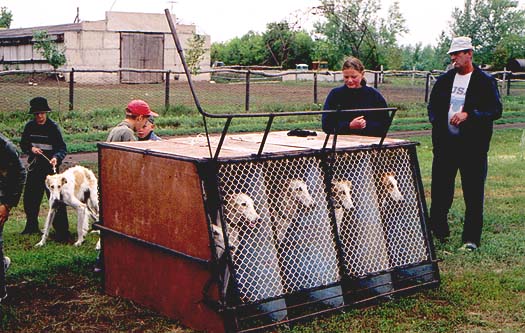
After three days in Omsk we left
for Saint Petersburg. This time we flew. After landing we caught a bus
into town and then took the underground to Alexander’s brother’s flat,
where we would stay while in Saint Petersburg. We did some sightseeing
around the town the first day and then on the second day we went out to
the Peterhof palace. This is a very beautiful palace that has been mostly
restored. It is surrounded by a large acreage filled with fountains, all
created to work by water pressure because there were no electrical pumps
at that time.
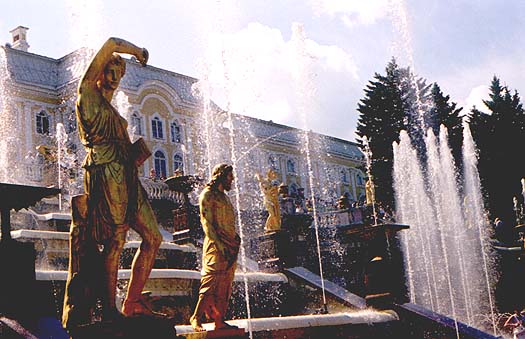 .
.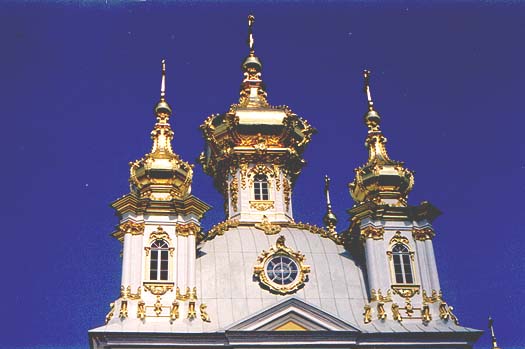
This was also the site of the Tsar’s
hunt from the late 1700’s until 1856, when it was moved to Gatchina. The
next day we visited Gatchina, which had been the home of the Tsar’s hunt
from 1856 until the fall of the Romanov dynasty in 1917. Some of the local
borzoi hunters took us to Gatchina. The old huntsmen’s houses and the houses
the borzoi lived in are still standing there. There were 4 borzoi to one
huntsman. The borzoi lived in buildings just across a small dirt street
from the huntsmen’s houses, which were about 50 feet away; each huntsman’s
house was directly across the small street from the house for the borzoi
they were in charge of. It was very interesting to see this; I could just
imagine how the dogs were kept and I could almost feel the presence of
the hunters and hounds of old. The huntsmen’s houses are still being lived
in, but the Borzoi houses are either not being used, or are being used
as storage buildings. We then walked a little ways down the road
to a Russian Orthodox Church, sitting like a cut jewel in the woods, with
its blue domes visible from a distance. This church was the church of the
huntsmen, and has been mostly restored. The huntsmen would come on horse
back with the borzoi to the church before the hunts. They would leave the
dogs and horses outside, go in for services, and then leave on the hunt.
It was very moving for me to see this place, were the borzoi of the Tsars
lived and walked over one hundred years ago.
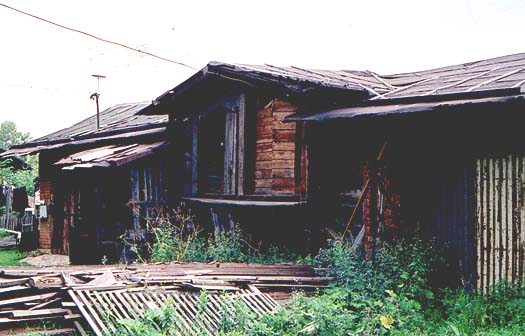 .
.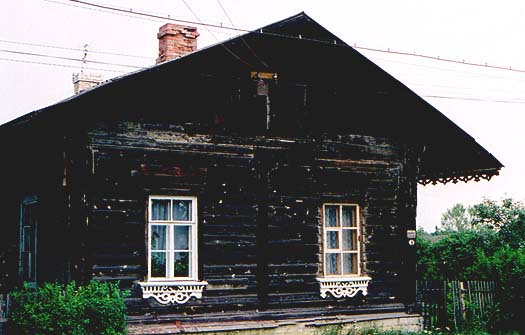
Borzoi House.
Huntsman's house.
After visiting the church, we drove
down the road to the Gatchina palace. This palace is not completely restored
yet. We toured the inside of the palace where they had displays of guns
and paintings of hunting scenes; I saw only one painting with borzoi but
there were a couple with greyhounds. We then walked around the grounds.
They also are not restored, but I think they are very similar to how they
would have been when the Tsars lived there. After all, a hundred years
ago they did not have lawn mowers. There is a lake on the grounds, and
beautiful wooded areas.
The next day in Saint Petersburg was a borzoi day; we
were picked up and driven a short ways out of town, to a field where the
hunters go to train their young Borzoi on hares. We set up for a barbeque,
which is common in Russian outdoor get-togethers, and more and more people
started showing up with their borzoi. It was a nice day of people, borzoi,
food and drink. Did I mention that they drink vodka in Russia? It was a
great way to see some of the hunting borzoi of Saint Petersburg, and a
wonderful way to meet people whose passion is to allow their borzoi to
exercise their passion, by taking them hunting.
After a very nice day we
were off to the train station for an overnight train trip to Moscow.
Moscow has an official population of about 14 million, but there is also
an unofficial population of migrant or illegal workers, and the real population
is estimated at being closer to a mind-boggling 24 million. We spent 3
days in Moscow, a mixture of sightseeing and visiting hunters and their
borzoi at their homes. We visited borzoi hunters and their dogs in their
flats and houses and we made a short trip out of town to see even more
borzoi. On my last day in Moscow we had another barbeque at the home of
a borzoi breeder.
I learned a lot about borzoi
in their homeland from my trip to Russia. I also learned a lot about the
Russian borzoi people; in many ways they are like sighthound hunters in
this country. They are very interested in the running abilities of their
dogs and in keeping their native breed true to what it was in the days
of the Tsars. I was impressed with their dedication to the breed; many
of them kept 3 or 4 borzoi in small flats, in the middle of very large
cities. There are very few large kennels such as are common in the US.
With the functional borzoi
losing ground to a more generic show variety in America and elsewhere,
I was glad to see that in their native country, there are still a large
number of people dedicated to preserving the hunting function and thereby
the original form of the breed. Russia may be the last country to hold
on to the borzoi as it was, through the popularity and importance given
to hunting there. I had a wonderful time in Russia. The people and their
hospitality were great; I was there for three weeks and I never spent a
night in a hotel. I was very well cared for and everywhere I went, everyone
fed me and made sure I was comfortable. The hunting borzoi is alive and
well in Russia, and I hope it stays that way because it is losing ground
everywhere else in the world.
I would like to thank
all the people in Russia that made my trip so enjoyable and especially
my friend Alexander Lyutin. Without him the trip would not have been possible.
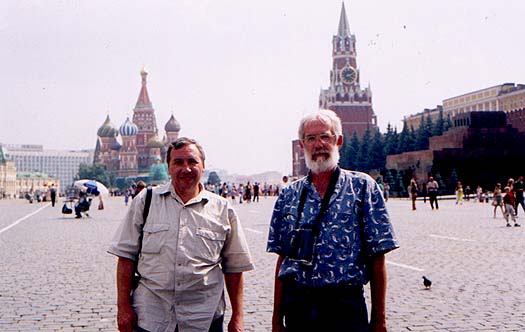
Alexander and Me in Red Square.
Home
Copyright Rey and Yvonne McGehee 2004.